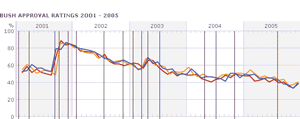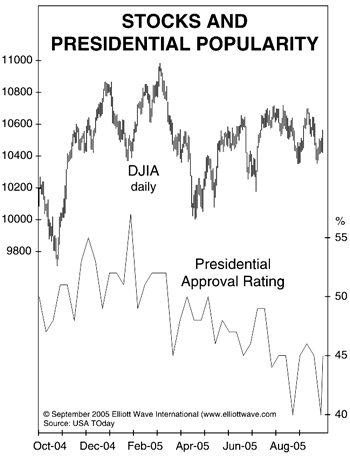
Bush Approval Rating Tracker
Every US president's popularity among the American public is measured by approval ratings; opinion polls conducted weekly or monthly by a host of polling companies.
Chart shows how George W Bush has fared over the last five years in relation to key events of his presidency.
BBC
To see the key events click here. For the chart and events of 2006 click here.
|
| April 2007 |
| S |
M |
T |
W |
T |
F |
S |
|
1
|
2
|
3
|
4
|
5
|
6
|
7
|
|
8
|
9
|
10
|
11
|
12
|
13
|
14
|
|
15
|
16
|
17
|
18
|
19
|
20
|
21
|
|
22
|
23
|
24
|
25
|
26
|
27
|
28
|
|
29
|
30
|
|
|
|
|
|
|
|
 |
|
« Previous |
Main Page
| Next »
|
Shifting Political Winds Pump Up Democrats
By: Pete Kendall, October 16, 2006 |
Probably by the Congressional election in 2006 and certainly by the Presidential election in 2008, the electorate’s seething desire to “throw the bums out” will completely reshape the political landscape.
The Elliott Wave Financial Forecast, October 2004 |
The link shows President Bush's approval ratings versus world events, on a 1-year and 5-year time scale. From the charts, I conclude that his approval rating has absolutely nothing to do with world events, or is responses to them? Strangely, his rating sky-rocketed right after the 9-11 attacks, then returned to the mean. Given the socionomic hypothesis, I wonder if (a) any US President would have had a similar curve, regardless of affiliation/policy and (b) if the social mood had been positive, would that part of the curve be the other way (a large dip, presumably because the President failed to guard against obvious warnings)?
-- Ian Gallimore
Right, the president’s popularity is not a function of his personality or performance or the events that take place during his time in office, but the direction of social mood. The two are not always in sync, however. There are times when presidential approval diverges dramatically from the trend in the social mood, as measured by the stock market. One key one that The Elliott Wave Financial Forecast has discussed as relevant to current trend is Lyndon Johnson’s approval rating in 1966-1968, which also tracked lower against a rising Dow. The May issue shows the similarity between the “Presidential Divergence” in 2006 and that of 1968 but notes that the current discrepancy “has been building for building for roughly twice as long. A longer social divergence equates to a bigger turn.” EWFF added, “The potential for social disruption is far more extreme than it was in 1969. This undoubtedly reflects the higher degree of the current trend change.”

A year ago, EWFF showed this chart of Bush’s approval rating against the Dow, and, after observing a “sea change” in the political arena, issued the forecast at the top of this post (for the full entry see Additional References below). We’ll have to see what happens on Election Day, but there is a good chance that the first evidence of the political revolution that we talked about here last year will make an appearance. Interestingly, one of the key figures that we discussed in that issue, California Gov. Arnold Schwarzenegger, has bounced off a low popularity floor of 37% approval. In a stunning reversal of fortune, Schwarzenegger’s approval rating has rebounded to 56%, and he is considered a shoe-in for re-election. “You rarely see in politics anybody come up from where the governor was,” says a pollster. What’s his secret? USA Today reported on October 13 that Schwarzenegger “surrounded himself with people who have encouraged him to wrap himself around the Democratic flag, and it has worked.” Here’s the headline:
California Republican Regains Popularity as He Embraces Democrats
As much as they might like to, more established politicians cannot change their stripes like Schwarzenegger. So, there’s a good chance the upheaval anticipated in EWFF is ready to begin unfolding. It promises to produce some fascinating political theater.
|
|
|
Additional References
October 2005, EWFF
The larger the downtrend, the larger the political upheaval. This one is so big that political turmoil is actually getting out in front of the breakdown. According to pollsters at Zogby International, Bush’s approval rating is so low that he “Would Lose to Every Modern President.” The social scene is setting up as it did at the peak in 1968, when Lyndon Johnson’s popularity plunged so dramatically that he declined to run. Then as now, the Dow was within striking distance of a Cycle degree peak and the Value Line Geometric Average was actually at a new all-time high, one that would remain in place for the next 15 years. As then, emerging political unrest is spreading fast. Congress’ political standing is also at its lowest level since 1997. “Dark and ominous clouds are gathering over the Republican Party,” says a September 26 issue of the Washington Post. That was before Wednesday’s indictment of House Majority Leader Tom DeLay. “This is not what the Republicans envisioned 11 months ago, when they were returned to office as a powerful one-party government,” says today’s NY Times of the Republicans’ “Sea of Trouble.”
At the state and local level, populist fervor is rising. In Pennsylvania, after the state legislature voted itself a “middle of the night pay raise” in July, a wave of outrage hit the newspapers and airwaves. Since a similar whiff of fury failed to amount to anything in 1995, few Pennsylvanians “predicted the level of hostility or how long it could simmer.” “The political establishment in Harrisburg underestimated the unifying power of outrage,” said the coordinator of a September 28 protest rally. In California, politicians are scratching their heads over the emergence of “grumpy voters. As they look around them and toward the future, residents of the Golden State are turning gloomy. By a 2-to-1 margin, registered voters in California say the state’s economy is now in ‘bad times’ rather than good.” In a “stunning drop,” the approval rating of action hero turned California Governor Arnold Schwarzenegger is down to 31%. “The word I hear most from business people is ‘surprise’ that he has squandered so much of his political capital and their money,” said a Republican political consultant. This is nothing. Probably by the Congressional election in 2006 and certainly by the Presidential election in 2008, the electorate’s seething desire to “throw the bums out” will completely reshape the political landscape. |
|
Post a comment
|
|
|
 |
| RECENT ARTICLES |
 |
April 16, 2007
Does Imus Cancellation Radio a Bear Market Signal?
read more |
April 12, 2007
One Small Coffee Shop Uprising for Starbucks, a Grande Leap for Labor
read more |
April 11, 2007
Dazzling Finish: Cars Bring Once-Boring Shades To Life
read more |
April 10, 2007
T in T-Line Stands for Top
read more |
April 5, 2007
The Fight for a Free Vermont? Must be a Big, Big Turn
read more |
|
|
| ARTICLE COMMENTS |
 |
|
|
|
|
